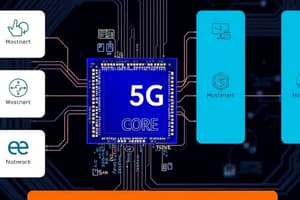Podcast
Questions and Answers
In the context of 5G deployment options, which architecture involves the user equipment (UE) maintaining simultaneous connections to both LTE and NR, with the LTE connection anchored in the EPC?
In the context of 5G deployment options, which architecture involves the user equipment (UE) maintaining simultaneous connections to both LTE and NR, with the LTE connection anchored in the EPC?
- Non-standalone LTE and NR under EPC (Option 3) (correct)
- Non-standalone NR and LTE under 5GC (Option 4)
- Standalone NR under 5GC (Option 2)
- Standalone LTE under 5GC (Option 5)
In 5G Option 3, the User Equipment (UE) can transmit data only through either LTE or NR, but not simultaneously.
In 5G Option 3, the User Equipment (UE) can transmit data only through either LTE or NR, but not simultaneously.
False (B)
In the context of 5G Core, what architectural functional entity is responsible for determining the Dedicated Core Network (DCN) based on the UE's usage type, especially in the context of network slicing?
In the context of 5G Core, what architectural functional entity is responsible for determining the Dedicated Core Network (DCN) based on the UE's usage type, especially in the context of network slicing?
MME
In the context of 5G network slicing using DÉCOR, if a UE initially attaches targeting Slice 2 (DCN #2), the __________ will make the initial DCN selection based on the UE's attach request.
In the context of 5G network slicing using DÉCOR, if a UE initially attaches targeting Slice 2 (DCN #2), the __________ will make the initial DCN selection based on the UE's attach request.
Match the following architectural components relevant to Option 3 deployment with their respective key functions:
Match the following architectural components relevant to Option 3 deployment with their respective key functions:
Which of the following is the most accurate description of eDECOR in the context of 5G network slicing?
Which of the following is the most accurate description of eDECOR in the context of 5G network slicing?
The separation of Control Plane (CP) and User Plane (UP) is not a key enhancement introduced in 5G EPC to support Option 3 deployments.
The separation of Control Plane (CP) and User Plane (UP) is not a key enhancement introduced in 5G EPC to support Option 3 deployments.
With respect to network slicing, what is the primary advantage of using a 'separated CN' architecture, as opposed to a shared core network?
With respect to network slicing, what is the primary advantage of using a 'separated CN' architecture, as opposed to a shared core network?
When considering the evolution towards 5G using network slicing, introducing a 5G slice for enhanced Mobile Broadband (eMBB) or Fixed Wireless Access (FWA) is typically undertaken as a __________ step to maintain existing services.
When considering the evolution towards 5G using network slicing, introducing a 5G slice for enhanced Mobile Broadband (eMBB) or Fixed Wireless Access (FWA) is typically undertaken as a __________ step to maintain existing services.
Match the RAN Option variants with the correct descriptions:
Match the RAN Option variants with the correct descriptions:
What is the primary function of the CUDB (Converged User Data Base) in 5G EPC in the context of Option 3?
What is the primary function of the CUDB (Converged User Data Base) in 5G EPC in the context of Option 3?
In Option 3, dynamic LTE/NR switching is not essential.
In Option 3, dynamic LTE/NR switching is not essential.
When implementing network slicing with Separated CNs, what is the characteristic that is directly improved?
When implementing network slicing with Separated CNs, what is the characteristic that is directly improved?
In the evolution of 5G introduction, 5G aims for __________ evolution to 5GC.
In the evolution of 5G introduction, 5G aims for __________ evolution to 5GC.
Match architecture to routing:
Match architecture to routing:
Function of eNodeB.
Function of eNodeB.
For a non-specialized network, the network core cannot be different.
For a non-specialized network, the network core cannot be different.
What is the name in a separated CNs which is optimized for new services?
What is the name in a separated CNs which is optimized for new services?
Network slices is used to introduce _________ to eMBB
Network slices is used to introduce _________ to eMBB
Match which radio access technology is routed through each variant:
Match which radio access technology is routed through each variant:
Flashcards
Dual Connectivity
Dual Connectivity
Enables User Equipment (UE) to send and receive data simultaneously to/from LTE and NR.
5G Option 3
5G Option 3
A 5G deployment option where non-standalone LTE and NR operate under EPC (Evolved Packet Core).
CP and UP Separation
CP and UP Separation
Separation of Control Plane (CP) and User Plane (UP) functions within the network architecture.
Network Slicing
Network Slicing
Signup and view all the flashcards
DÉCOR (Dedicated Core)
DÉCOR (Dedicated Core)
Signup and view all the flashcards
eDECOR
eDECOR
Signup and view all the flashcards
RAN Option 3
RAN Option 3
Signup and view all the flashcards
RAN Option 3a
RAN Option 3a
Signup and view all the flashcards
RAN Option 3x
RAN Option 3x
Signup and view all the flashcards
CN Separation
CN Separation
Signup and view all the flashcards
Study Notes
- 5G Core Session 2 is about 5G EPC, by Farhan Ahmad Khan
Agenda
- Option 3 is discussed
- Enhancements to EPC i.e. 5G EPC
- Discussion of DÉCOR and eDECOR
- The agenda includes network slicing over Option 3
- Option 3 Variants, including options 3a and 3x are discussed
5G Deployment Options Covered
- Standalone LTE under EPC (option 1)
- Standalone NR under 5GC (option 2)
- Standalone LTE under 5GC (option 5)
- Non-standalone LTE and NR under EPC (option 3)
- Non-standalone NR and LTE under 5GC (option 4)
- Non-standalone LTE and NR under 5GC (option 7)
5G – Option 3
- Option 3 enables User Equipment (UE) to both send and receive data simultaneously over both LTE and NR
- For Option 3 to work, the following must be supported: UE, eNB (LTE), gNB(NR), MME
Option 3 – 5G EPC
- Network elements include eNode B/gNode B, S-GW, P-GW, MME, HSS, PCRF, and the Internet
- Enhancements to support Option 3 include separation of control plane (CP) and user plane (UP)
- Supports 5G subscription handling, high data rates for 5G, dynamic LTE/NR switching, and network slicing (DECOR)
5G EPC Enhancements to Support Option 3
- Supports 5G user data rates, 5G subscriber profiles, NW slicing of subscriptions, and automated provisioning
- Supports 5G/NR access control, QoS data rates control, 5G/NR usage reporting, Dual-Connectivity LTE/NR, and LTE/NR NW slicing
- Supports 5G user data rates for gNB, and 5G/NR usage reporting and access control for eNB
- It also supports UP path control (1/3/3a/3x) for gNB, and Dual-Connectivity LTE/NR
- 5G user data rates and DPI and traffic filtering are supported
- Supports 5G User and Policy profile provisioning in CUDB and SAPC, and NW slicing profile provisioning in CUDB
- Policy control is supported on LTE/NR access, QoS data rates control, and LTE/NR mobility-based policy
- Supports QoS data rates control, 5G/NR usage reporting, CUPS distribution & control, and UP traffic rules
Network slicing in 5G EPC via DÉCOR (Dedicated Core)
- The eNB selects a 1st MME
- The MME decides DCN based on UE usage type
- Authentication information request
- Reroutes message request
- The eNB selects MME2 and attach procedure continues
Network slicing in 5G EPC via eDECOR
- The NNSF selects DCN based on the received DCN-ID
- The eNode B MME may evaluate DCN selection and perform rerouting
Option 3 Variants
- RAN (Radio Access Network) Option 3 uses MCG (Master Cell Group) split bearer
- RAN Option 3a uses MCG bearer or SCG (Secondary Cell Group) bearer
- RAN Option 3x uses SCG Split bearer
- For Option 3, S1'-C always terminates on LTE eNB
- LTE eNB decides whether UP traffic is routed via NR gNB and/or LTE eNB (split bearer in LTE eNB)
- For Option 3a, S1'-C always terminates on LTE eNB, and the LTE eNB decides whether a bearer is routed to LTE eNB or NR GNB (bearer switching in SGW)
- For Option 3x, S1'-C always terminates on LTE eNB
- NR gNB decides whether UP traffic is routed via NR gNB and/or LTE eNB (split bearer in NR GNB)
Studying That Suits You
Use AI to generate personalized quizzes and flashcards to suit your learning preferences.




